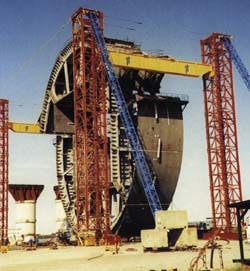Jacking system withstands high winds for Spar hull section assembly
Vicky Wilson
Contributing Editor
A four-tower RMS Push-Up system at the Aker Rauma yard in Finland lifting the first of 21 steel sections weighing up to 850 tons for the Genesis Field Spar Push-Up system.The unique heavy lift system "Push Up" developed by Rigging Management Sweden has had considerable success for offshore construction projects since its introduction 15 years ago. Working on a jacking principle, the flexible Push-Up system handles heavy single-lift loads with maximum operational safety and precision in temperatures as low as -30°C using multiples of two masts depending on the size of the lift.
Controlled remotely by operators at the base of each mast the load is placed on a lock plate above the jacks and raised one meter at a time. After each lift the load is locked off, the jacks retracted, a piston inserted to maintain the load and the jacks repositioned to lift the load another meter.
The mast bracing has been specially developed to provide even stress distribution and the pistons are machined to exact tolerances so that the stack of pistons will take the full load and the masts only have to take wind loads. The system can be braced completely from within the base areas of the masts for lifts in confined situations. The heaviest lift operations undertaken by RMS so far was the Gyda jacket for Aker. The 2,700 tons jacket was raised 90 meters using four masts in an operation that took eight hours.
Genesis Spar
RMS is currently working for Aker Rauma Offshore in Finland in a contract that involves assembling 21 steel spar hull sections weighing up to 2,000 tons each for the Genesis Field Spar project. Each section of the spar is fabricated in two parts as the 37.2 meter hull diameter is too wide to be fabricated in complete sections under one roof.Once completed, the two parts are taken outside for mating by RMS. The smaller top sections, weighing up to 850 tons each, are raised 25 meters in an operation that takes
4 - 4 1/2 hours and to tolerances of +/- 20mm. Once the upper section is in position, the lower section is skidded underneath and the two joined together. The complete unit is then connected to the other completed sections.
When finished, the hull length will measure 215 meters and weigh over 25,000 tons. The 21 single lifts are scheduled to take place every third week during a 17-month period and to date a total of 14 sections have already been completed.
"The alternative would have been to use a heavy lift barge," says managing director Jan-Erik Andersson, "But it would have been very expensive to bring in a barge every three weeks to complete each lift, whereas our Push-Up system remains in place throughout the project." The RMS Push-Up system also has the advantage of being extremely stable. With severe wind conditions often being experienced at the Finnish yard, a conventional heavy-lift barge would have proved too unstable, whereas the Push-Up system has been designed to lift in mean winds of up to 15m/second, equiv alent to Force 7.
Another advantage of the Push-Up system is that it knocks down easily into trailer-sized pieces so that it can be moved on to its next location. There have been relatively few developments to the system since Push-Up was first introduced, but Andersson points out that improvements in steel quality have meant that a base section for a 1,000-ton system was recently produced using the same dimensions as a previous system capable of lifting 600 tons.
Remote control
"We are also changing the control system so that each mast can be operated by one man using a remote control system," adds Andersson. In the existing system, each tower is controlled individually so a typical four-mast configuration requires four men to coordinate the lift operation.RMS now has a world-wide network of its Push-Up systems in place and particular success has been achieved in the Korean market where two Push-Up systems have completed 250 heavy lifts since 1988. For areas outside Western Europe, RMS provides the technical know-how and a back-up service. While masts and other equipment for new systems are built locally, Andersson stresses that the power units and hydraulic systems are always provided by RMS to ensure quality consistency.
For further information contact Jan-Erik Andersson, Rigging Management Systems: telephone +46 500 437070, fax +46 500 436740, e-mail [email protected] or web site http://www.rmsjea.se.
Copyright 1997 Oil & Gas Journal. All Rights Reserved.

